Demolition Contractors Raytown
Top Demolition Contractors Near Me in Raytown
Get 3 FREE Demolition Experts quotes for your project today! Compare profiles, reviews, accreditations, portfolio, etc... and choose the best deal.
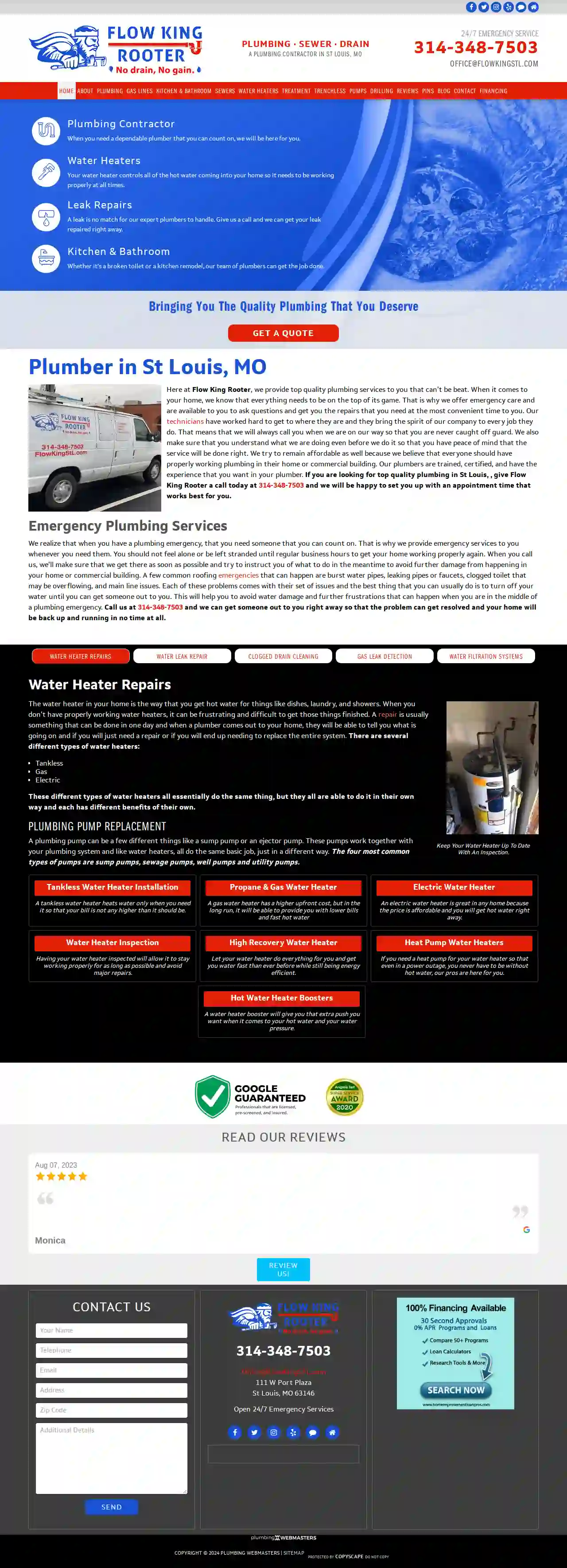
Flow King Rooter Plumbing
512 reviews111 W Port Plaza, 111 W Port Plaza St Louis, MO, St. Louis, 63146, USWhen you need a dependable plumber that you can count on, we will be here for you. Here at Flow King Rooter, we provide top quality plumbing services to you that can’t be beat. When it comes to your home, we know that everything needs to be on the top of its game. That is why we offer emergency care and are available to you to ask questions and get you the repairs that you need at the most convenient time to you. Our technicians have worked hard to get to where they are and they bring the spirit of our company to every job they do. That means that we will always call you when we are on our way so that you are never caught off guard. We also make sure that you understand what we are doing even before we do it so that you have peace of mind that the service will be done right. We try to remain affordable as well because we believe that everyone should have properly working plumbing in their home or commercial building. Our plumbers are trained, certified, and have the experience that you want in your plumber. If you are looking for top quality plumbing in St Louis, , give Flow King Rooter a call today at 314-348-7503 and we will be happy to set you up with an appointment time that works best for you.
- Services
- Why Us?
- Gallery
Get Quote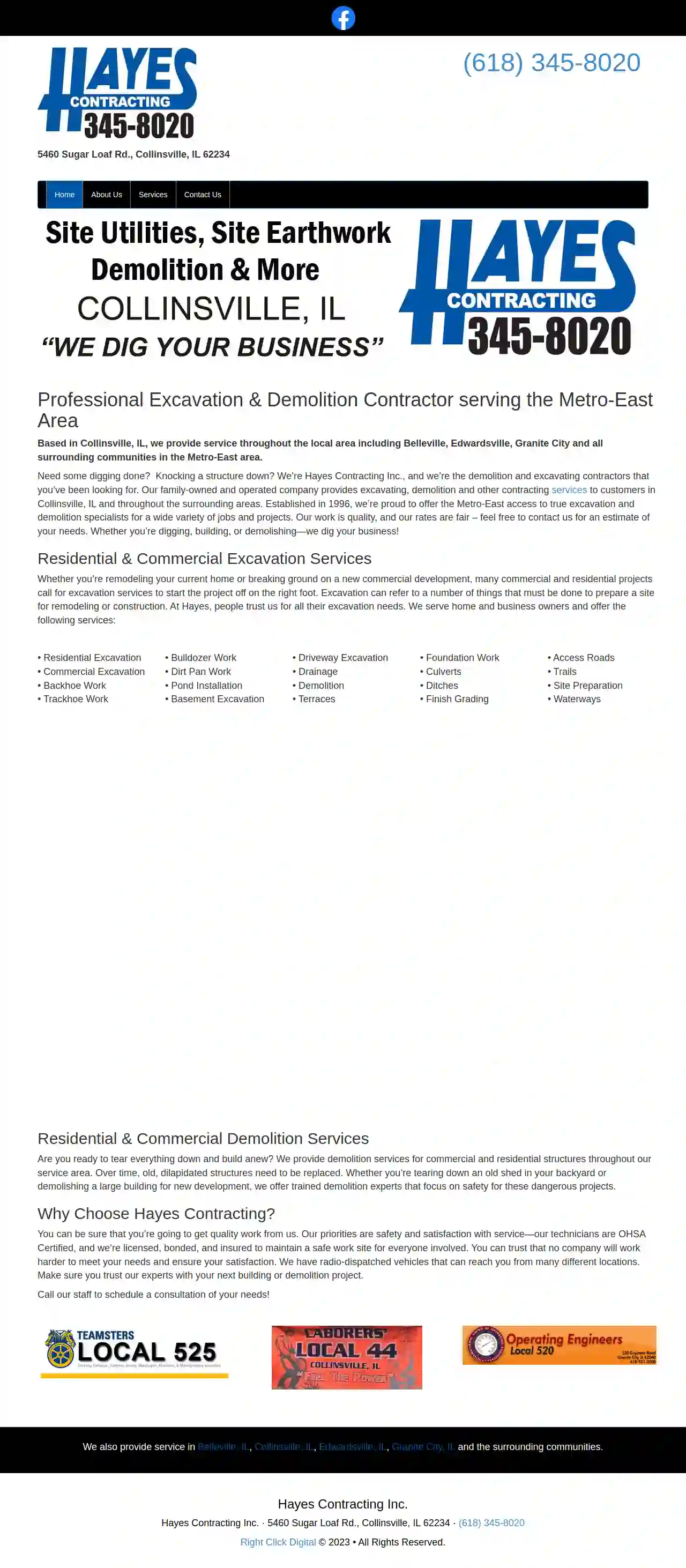
Hayes Contracting Inc
53 reviews5460 Sugar Loaf Rd., Collinsville, 62234, USProfessional Excavation & Demolition Contractor serving the Metro-East Area Based in Collinsville, IL, we provide service throughout the local area including Belleville, Edwardsville, Granite City and all surrounding communities in the Metro-East area. Need some digging done? Knocking a structure down? We’re Hayes Contracting Inc., and we’re the demolition and excavating contractors that you’ve been looking for. Our family-owned and operated company provides excavating, demolition and other contracting services to customers in Collinsville, IL and throughout the surrounding areas. Established in 1996, we’re proud to offer the Metro-East access to true excavation and demolition specialists for a wide variety of jobs and projects. Our work is quality, and our rates are fair – feel free to contact us for an estimate of your needs. Whether you’re digging, building, or demolishing—we dig your business!
- Services
- Why Us?
- Gallery
Get Quote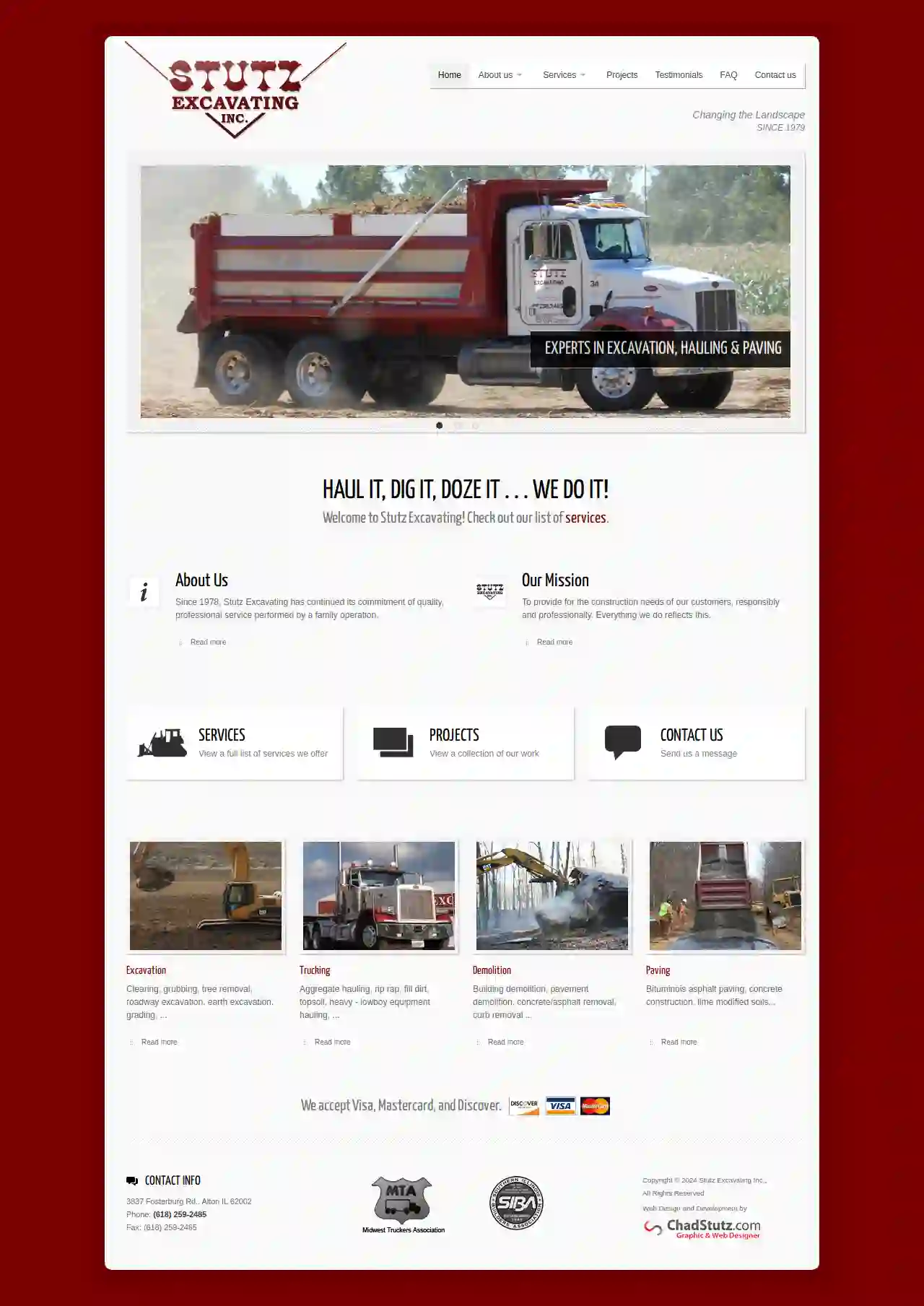
Stutz Excavating Inc
4.227 reviews3837 Fosterburg Rd., Alton, 62002, USAbout Stutz Excavating Stutz Excavating, Inc. has its principal base of operations located at 3837 Fosterburg Road in Alton, IL. Since 1979, Stutz Excavating has continued its commitment of quality, professional service performed by a family operation. Our primary focus of service is heavy highway construction, local roads and streets, storm sewer installation, parking lot construction, trucking, paving, and demolition. We are prequalified with the Illinois Department of Transportation, the Capital Development Board, and other local agencies. Through the years we have successfully completed many contracts overseen by these agencies and civil engineering firms.
- Services
- Why Us?
- Accreditations
- Our Team
- Testimonials
- Gallery
Get Quote
Ammerman Excavating & Services
2.52 reviews100 Ammerman Rd, York, 17315, USAmmerman Excavating: Your Trusted Partner for Excavation Services Ammerman Excavating is a family-owned and operated business with over 20 years of experience in the excavation industry. We are committed to providing our clients with high-quality services at competitive prices. Our team of experienced professionals is dedicated to delivering exceptional results on every project, no matter how big or small. We understand that excavation projects can be complex and require a high level of expertise. That's why we take a personalized approach to every job, working closely with our clients to ensure their needs are met. From site preparation to utility installation, we handle all aspects of your excavation project with precision and care. At Ammerman Excavating, we are committed to safety and environmental responsibility. We use the latest equipment and techniques to minimize our impact on the environment and ensure the safety of our workers and the public. Contact us today to discuss your excavation needs. We are confident that we can provide you with the best possible service.
- Services
- Why Us?
Get Quote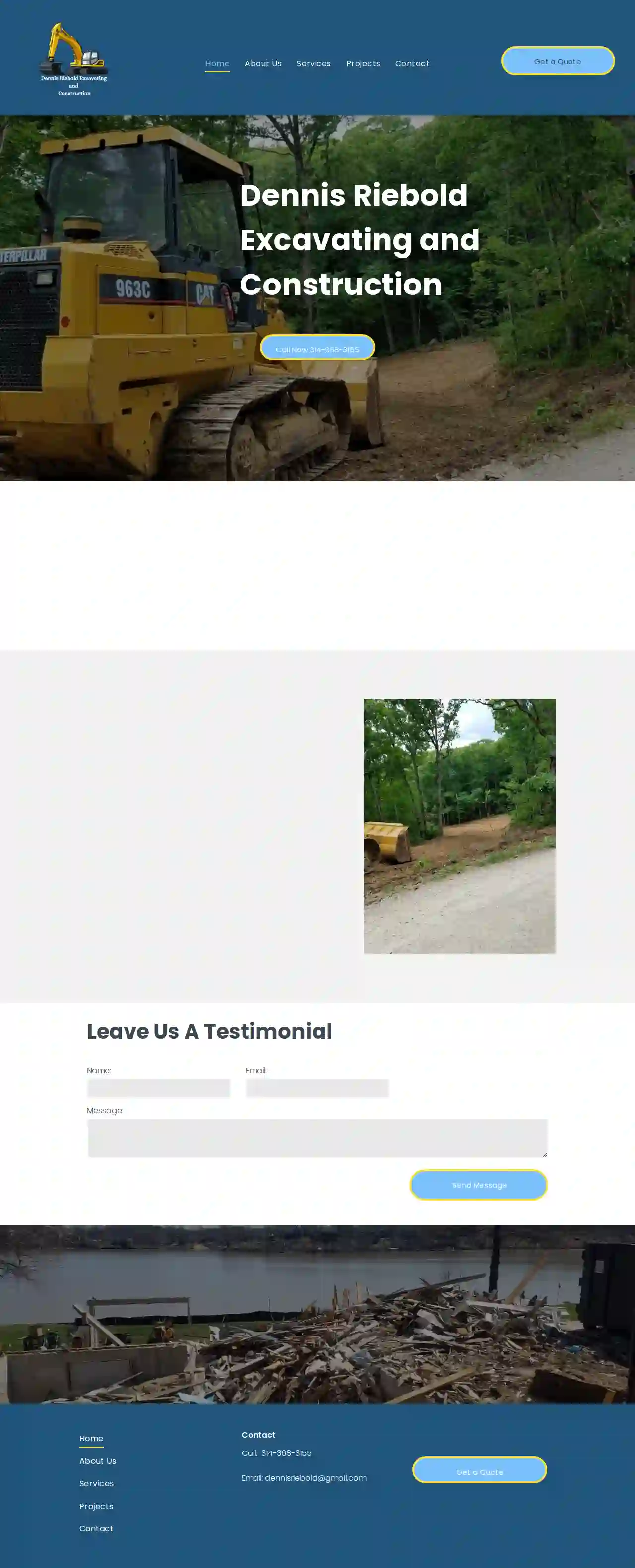
Riebold Excavating & Construction .
54 reviewsSt. Louis, USDennis Riebold Excavating and Construction Dennis Riebold Excavating and Construction has been in business for over 30 years, developing subdivisions, new construction, custom homes, and commercial sites. We also do a lot of tear-down work; removing old driveways and tearing down buildings so that the site can be redeveloped. Our experience in excavation, grading, and underground utility installation gives us a unique edge in the industry. We are able to take on projects from start to finish, designing and developing the site as needed. We take pride in our reputation as a professional contractor who always puts the customer first. With our extensive experience in all aspects of excavation and construction, we can handle any project, large or small. We're also experts at tearing out old driveways and preparing sites for new pavement.
- Services
- Why Us?
- Gallery
Get Quote
Bullseye Contracting llc
57 reviewsSt. Louis, USBuilding Trust with Quality Work Bullseye Contracting offers general excavation work including: pond & lake building, road & property line clearing, leveling roads, culvert & ditch installation, basement excavation, demolition, hauling, soil retention, brush clearing, water retention & diversion, wildlife land management, hunting food plots and pad prep for portable storage sheds & buildings! We offer an end-to-end client experience that includes communication, budgeting, staffing, on-site organization, along with solid, quality handiwork every time. Our mission at Bullseye Contracting is to provide our clients with exceptional construction services that exceed their expectations. We strive to deliver high-quality workmanship, on-time completion, and cost-effective solutions.
- Services
- Why Us?
- Gallery
Get Quote
Kamadulski Excavating & Grdng
4.314 reviews4336 HWY 162, Granite City, 62040, USHistory of KAMEX Kamadulski Excavating & Grading Co, Inc. was founded in 1958 by Leo and Fannie Kamadulski. The Kamadulski family owned and operated the company until Leo and Fannie’s son, David Kamadulski, sold the company in 2019. The mission of the Kamadulski family was to deliver quality service to their customers at a fair price. Ryan Fischer and Mark Crays joined the company in 2013. Ryan and Mark purchased stock in the company in 2015 and completed the purchase in 2019. In 2021, the current ownership group rebranded the company as KAMEX. KAMEX has become an industry leader in the St. Louis Metro East. The company continues to expand into new sectors, including Commercial Warehouse Infrastructure, Environmental Landfill Cell Construction, Federal USACE Projects, Heavy Highway, Large Scale Transmission Water & Sewer Mains, Industrial, Mechanical, and Residential Subdivisions. Our Story Strong values of hard work and lasting relationships continue to define our culture. We work together as a team, supporting and encouraging each other. We have created an environment that values success in terms of relationships and results. Our mission is to offer our customers a quality experience and our staff an outstanding place to work and build their own legacy.
- Services
- Why Us?
- Gallery
Get Quote
Excavating St. Louis
51 reviewsBarnhart, USResidential & Commercial Excavation Services throughout St. Louis City, County & Jefferson County No job is too large or too small, we are here to help. Our team of skilled professionals is here to provide you with all your excavation needs. We specialize in residential and commercial projects, including sewer line repairs, land clearing, site preparation, and grading. At Excavating St. Louis, we are committed to delivering exceptional services that exceed your expectations. Contact us today to learn more about how we can help you with your next project. Call (636) 288-6627 for your free estimate today. Trusted Experience Whether you’re planning a new build or in need of a sewer line repair anywhere in St. Louis and Jefferson County, we have you covered. With over 20 years in the industry, we are able to plan and execute a variety of excavating projects that include land clearing, digging, grading, demolition and sewer line repairs. Professional Service We are experienced, fully insured professionals ready to provide prompt and reliable services. We know how to prioritize and multi-task to ensure your project is completed with quality workmanship. Count on us to provide efficient, safe, and high-quality sitework services.
- Services
- Why Us?
- Gallery
Get Quote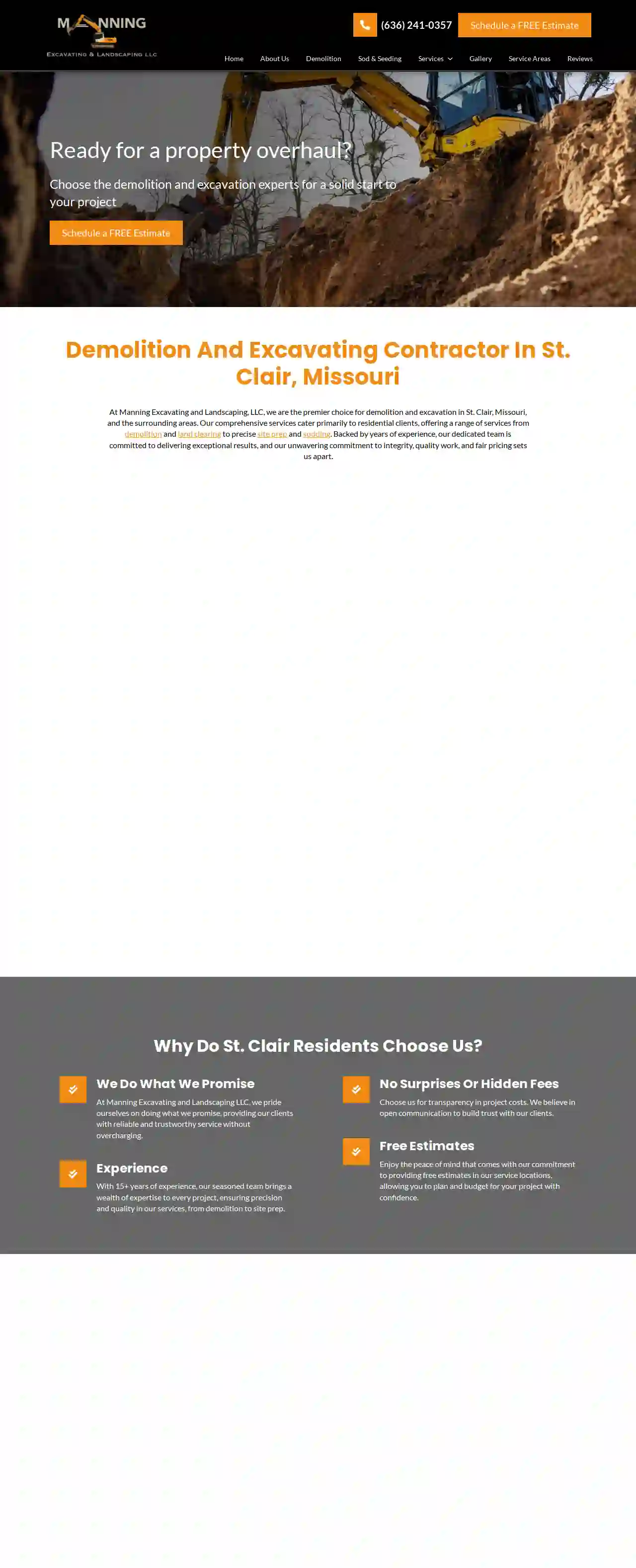
Manning Excavating and Landscaping, LLC
523 reviewsSaint Clair MO, Saint Clair, 63077, USManning Excavating and Landscaping, LLC: Your Trusted Partner for Demolition and Excavation in St. Clair, Missouri At Manning Excavating and Landscaping, LLC, we are the premier choice for demolition and excavation in St. Clair, Missouri, and the surrounding areas. Our comprehensive services cater primarily to residential clients, offering a range of services from demolition and land clearing to precise site prep and sodding. Backed by years of experience, our dedicated team is committed to delivering exceptional results, and our unwavering commitment to integrity, quality work, and fair pricing sets us apart. We understand that your property is an investment, and we treat it with the utmost care and respect. Our team of skilled professionals is equipped with the latest technology and equipment to ensure that your project is completed on time and within budget. We are also committed to providing our clients with clear and concise communication throughout the entire process. Whether you are planning a new construction project, a renovation, or simply need some land cleared, Manning Excavating and Landscaping, LLC is the company to call. Contact us today for a free estimate.
- Services
- Why Us?
- Gallery
Get Quote
St. Louis Excavation
583 reviews628 Brandon Ln., St Clair, 63077, USMunicipal & Residential Sewer Repair For over 30 years our family owned and operated excavation company has been completing residential sewer repairs and municipal sewer contracts in the greater Saint Louis area. Our company mission is to set the standard for professional excavation services in Saint Louis. Emergency Crews If you have a sewer emergency, please call to speak with an experienced professional who will begin the process of restoring your loss as quickly as possible. We can diagnose and complete your repair, reducing the amount of time you are inconvenienced. Call us 24/7 for drain cleaning, flooded basements, or sewer backups. Qualifications Master Plumbers Master Drainlayers St. Louis City & County Licensed Wastewater Treatment Operators DIS III Distribution License
- Services
- Why Us?
- Testimonials
- Gallery
Get Quote
Over 22,076+ Excavation Businesses on our platform
Our excavation contractors operate in Raytown and surroundings!
ExcavationHQ has curated and vetted Top Excavation Companies in and around Raytown. Find a top & trustworthy business today.
Frequently Asked Questions About Demolition Contractors
- Permits and Regulations: Obtain all necessary demolition permits and comply with local building codes and environmental regulations.
- Contracts: Have a clear and comprehensive contract with the demolition contractor outlining the scope of work, payment terms, and liabilities.
- Environmental Laws: Comply with environmental laws regarding hazardous material removal, waste disposal, and pollution control.
- Neighboring Property Rights: Respect neighboring property rights and take measures to prevent damage or disruption to adjacent properties.
- Worker Safety: Adhere to worker safety regulations and provide a safe working environment for demolition crews.
- 'Can I see proof of your licensing and insurance?' Verify their credentials and coverage.
- 'What experience do you have with projects like mine?' Ensure they have relevant expertise.
- 'Can you provide references from past clients?' Check their reputation and customer satisfaction.
- 'What are your safety protocols?' Prioritize contractors who emphasize safety.
- 'How will you handle hazardous materials?' Ensure they have proper procedures for asbestos or lead abatement.
- 'What is your timeline for completing the project?' Understand the project duration.
- 'How will you manage noise, dust, and debris?' Discuss mitigation measures for minimizing disruption.
- 'What are your payment terms?' Clarify payment schedules and any required deposits.
- General Liability Insurance: Covers bodily injury or property damage to third parties caused by the contractor's negligence.
- Workers' Compensation Insurance: Provides benefits to workers injured on the job.
- Pollution Liability Insurance: Covers costs associated with environmental contamination caused by demolition activities.
- Professional Liability Insurance: Protects against claims of negligence or errors in professional services, such as demolition planning or consulting.
What is asbestos abatement?
What are the legal considerations for demolition projects?
What questions should I ask a demolition contractor before hiring them?
What is the importance of insurance in demolition projects?
What is asbestos abatement?
What are the legal considerations for demolition projects?
- Permits and Regulations: Obtain all necessary demolition permits and comply with local building codes and environmental regulations.
- Contracts: Have a clear and comprehensive contract with the demolition contractor outlining the scope of work, payment terms, and liabilities.
- Environmental Laws: Comply with environmental laws regarding hazardous material removal, waste disposal, and pollution control.
- Neighboring Property Rights: Respect neighboring property rights and take measures to prevent damage or disruption to adjacent properties.
- Worker Safety: Adhere to worker safety regulations and provide a safe working environment for demolition crews.
What questions should I ask a demolition contractor before hiring them?
- 'Can I see proof of your licensing and insurance?' Verify their credentials and coverage.
- 'What experience do you have with projects like mine?' Ensure they have relevant expertise.
- 'Can you provide references from past clients?' Check their reputation and customer satisfaction.
- 'What are your safety protocols?' Prioritize contractors who emphasize safety.
- 'How will you handle hazardous materials?' Ensure they have proper procedures for asbestos or lead abatement.
- 'What is your timeline for completing the project?' Understand the project duration.
- 'How will you manage noise, dust, and debris?' Discuss mitigation measures for minimizing disruption.
- 'What are your payment terms?' Clarify payment schedules and any required deposits.
What is the importance of insurance in demolition projects?
- General Liability Insurance: Covers bodily injury or property damage to third parties caused by the contractor's negligence.
- Workers' Compensation Insurance: Provides benefits to workers injured on the job.
- Pollution Liability Insurance: Covers costs associated with environmental contamination caused by demolition activities.
- Professional Liability Insurance: Protects against claims of negligence or errors in professional services, such as demolition planning or consulting.